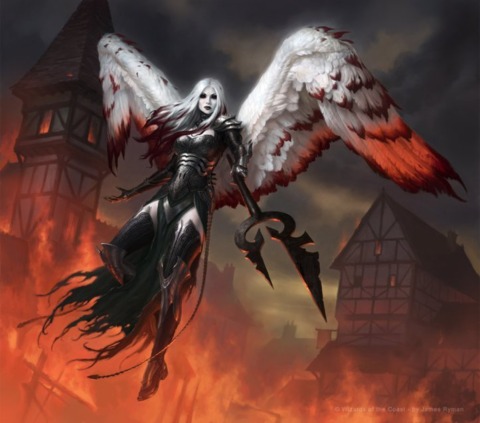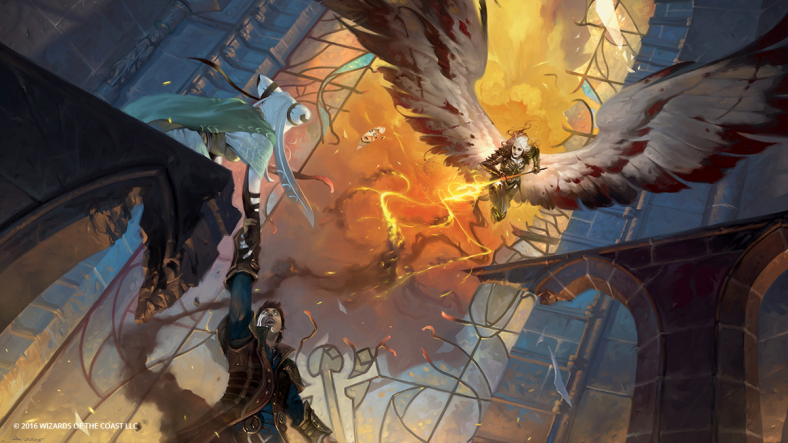Lemme Tell You A Story is my regularly returning foray into the world of storytelling in games of all kind. Storytelling as an art has always intrigued me, and as such, I love exploring the various ways a story can be told in videogames and board-games alike. Because of the interactive nature of these types of media, there are many dingles and dangles to keep in mind. Today's topic: Magic: the Gathering, the world-famous Collectable Card Game.
My introduction to Magic: the Gathering was the demo for one of the early Duels of the Planeswalkers games on the PS3. I had heard of the collectable card game, of course, but never bothered to entertain the thought of playing it. After the demo tickled my fancy, I ended up buying the 2012 version of DotP on Steam when I realised some of my gaming buddies had an interest in it, too. Around 4 MTG games later and several real-life decks at my disposal, here I am.

Let's get one thing out of the way: The gameplay of MTG is stellar, but this is about the flavour that oozes out of some of the cards.
The thing that gripped me about MTG right from the get-go was how the style, how coherent it all felt, and how it got it's hooks in my imagination. From the five different types of Mana that are used to cast your spells and summon allies to the artwork and the themes that run throughout the many different sets in the game: the idea of all these mighty warriors and wonderful beasts slugging it out was kinda dope, and it was the first time a board/card game managed to do more for me than just 'read effect, subtract numbers, next turn'. In a way, it was my gateway drug into board games in general.
The colours of mana and their associated play styles, creature types and themes were all the flavour I needed for a long while to get my thematic kick out of the game. But theme wasn't why I put together my decks. Gameplay dominated which cards I brought with me, which makes sense. That's why it took until I went to a pre-release draft for Shadows over Innistrad to fully and truly appreciate just how much story and flavour was hidden away in these cards.
Shadows over Innistrad is set in Innistrad, a realm based on gothic horror tropes. Vampires, townsfolk with pitchforks and torches, werewolves, grave-robbers, oozes, zombies, cathedrals, gargoyles, angels, cultists... You get the idea. I was familiar with some of the characters from this theme, since they remain some of the better cards in game in certain situations. With a limited amount of knowledge about the lore behind this part of the MTG world, I set out to rip open my boosters and construct a deck. That's when it hit me.
When they were looked at as a set of matching cards rather than individuals, a lot of the cards I held in my hands revealed the underlying story of this set. In this already weird realm, something weirder was going on. Captains of the guard turned into cult leaders. Werewolves are becoming more and more restless. Missionaries turned into inquisitors. Angels are turning on those they are meant to protect.

There were some cool mechanics introduced and re-implemented, that really compliment the underlying story behind the various cards you're laying out on your table as you fight your opponent. A mechanic called 'Investigate', for example, where you are thematically investigating the various strange and unusual happenings. In game terms, it simply means you can dig up more cards from your deck than your opponent, and thus gaining ground on them. The great angel Avacyn, who has featured in earlier sets set in Innistrad as a great protector of humans, now has a much more violent side added to her card. Whenever a non-angel dies, she goes mad and transforms into the Avacyn the Purifier, who damages every other living thing currently out on the game field. It just fits the theme of the character, this guardian gone rogue, in a way that's fun to play with (or play around) as well. I never once read the stories on the various channels owned by Wizards, but I knew exactly that the realm of Innistrad was in a dire situation, that some mysterious forces were at work here. All through the art, names and flavour text underneath the cards.
That got me thinking: how do the cards get designed? Did they have an idea for certain cool new game-mechanics and created a story and theme around them? Or did they have this idea for a gothic realm gone from bad to worse, and created some fitting gameplay-elements around them?
Both of these styles have been used in the past when developing cards. However, I feel that, with Shadows over Innistrad and sets that came out since then, the designers of these cards have straddled the fine line between theme and gameplay. I honestly believe their creativity is growing with every released set, and the designers perfected their craft of telling a story through the tiny cardboard things you're lying out on the table in order to summon imaginary monsters and fictional fireballs. I never thought I'd care for the fiction behind the game, but the way it adds to the gameplay really tickles the storyteller in me.
Log in to comment